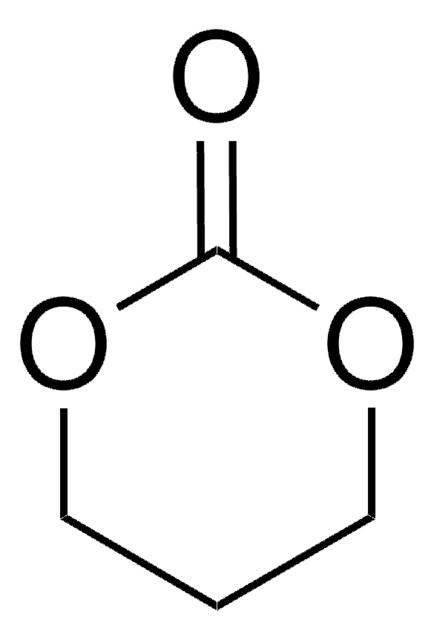If this product has an expiration or retest date, it will be shown on the Certificate of Analysis (COA, CofA). If there is no retest or expiration date listed on the product's COA, we do not have suitable stability data to determine a shelf life. For these products, the only date on the COA will be the release date; a retest, expiration, or use-by-date will not be displayed.
For all products, we recommend handling per defined conditions as printed in our product literature and website product descriptions. We recommend that products should be routinely inspected by customers to ensure they perform as expected.
For products without retest or expiration dates, our standard warranty of 1 year from the date of shipment is applicable.
For more information, please refer to the Product Dating Information document: https://www.sigmaaldrich.com/deepweb/assets/sigmaaldrich/marketing/global/documents/449/386/product-dating-information-mk.pdf
455067
4-(Hydroxymethyl)-1,3-dioxolan-2-one
Sinónimos:
(2-Oxo-1,3-dioxolan-4-yl)methanol, 3-Hydroxypropene carbonate, 3-Hydroxypropylene carbonate, 4-Methylolethylene carbonate, Glycerin carbonate, Glycerol 1,2-carbonate
Seleccione un Tamaño
Seleccione un Tamaño
About This Item
Productos recomendados
índice de refracción
n20/D 1.469 (lit.)
bp
137-140 °C/0.5 mmHg (lit.)
densidad
1.4 g/mL at 25 °C (lit.)
grupo funcional
carbonate
hydroxyl
cadena SMILES
OCC1COC(=O)O1
InChI
1S/C4H6O4/c5-1-3-2-7-4(6)8-3/h3,5H,1-2H2
Clave InChI
JFMGYULNQJPJCY-UHFFFAOYSA-N
Categorías relacionadas
Aplicación
- 4-[(prop-2-en-1-yloxy)methyl]-1,3-dioxolan-2-one (AGC) via Williamson ether synthesis with 3-bromoprop-1-ene.[1]
- Hyperbranched polyethers via copolymerization with cyclic carbonate containing phthalimide moieties.[2]
- (2-Oxo-1,3-dioxolan-4-yl)methyl benzeneacetate by reacting with phenylacetyl chloride.[3]
Código de clase de almacenamiento
10 - Combustible liquids
Clase de riesgo para el agua (WGK)
WGK 1
Punto de inflamabilidad (°F)
230.0 °F - closed cup
Punto de inflamabilidad (°C)
110 °C - closed cup
Equipo de protección personal
Eyeshields, Gloves, multi-purpose combination respirator cartridge (US)
Elija entre una de las versiones más recientes:
¿Ya tiene este producto?
Encuentre la documentación para los productos que ha comprado recientemente en la Biblioteca de documentos.
Los clientes también vieron
-
How can I determine the shelf life / expiration / retest date of this product?
1 answer-
Helpful?
-
-
How is shipping temperature determined? And how is it related to the product storage temperature?
1 answer-
Products may be shipped at a different temperature than the recommended long-term storage temperature. If the product quality is sensitive to short-term exposure to conditions other than the recommended long-term storage, it will be shipped on wet or dry-ice. If the product quality is NOT affected by short-term exposure to conditions other than the recommended long-term storage, it will be shipped at ambient temperature. As shipping routes are configured for minimum transit times, shipping at ambient temperature helps control shipping costs for our customers. For more information, please refer to the Storage and Transport Conditions document: https://www.sigmaaldrich.com/deepweb/assets/sigmaaldrich/marketing/global/documents/316/622/storage-transport-conditions-mk.pdf
Helpful?
-
Active Filters
Nuestro equipo de científicos tiene experiencia en todas las áreas de investigación: Ciencias de la vida, Ciencia de los materiales, Síntesis química, Cromatografía, Analítica y muchas otras.
Póngase en contacto con el Servicio técnico







